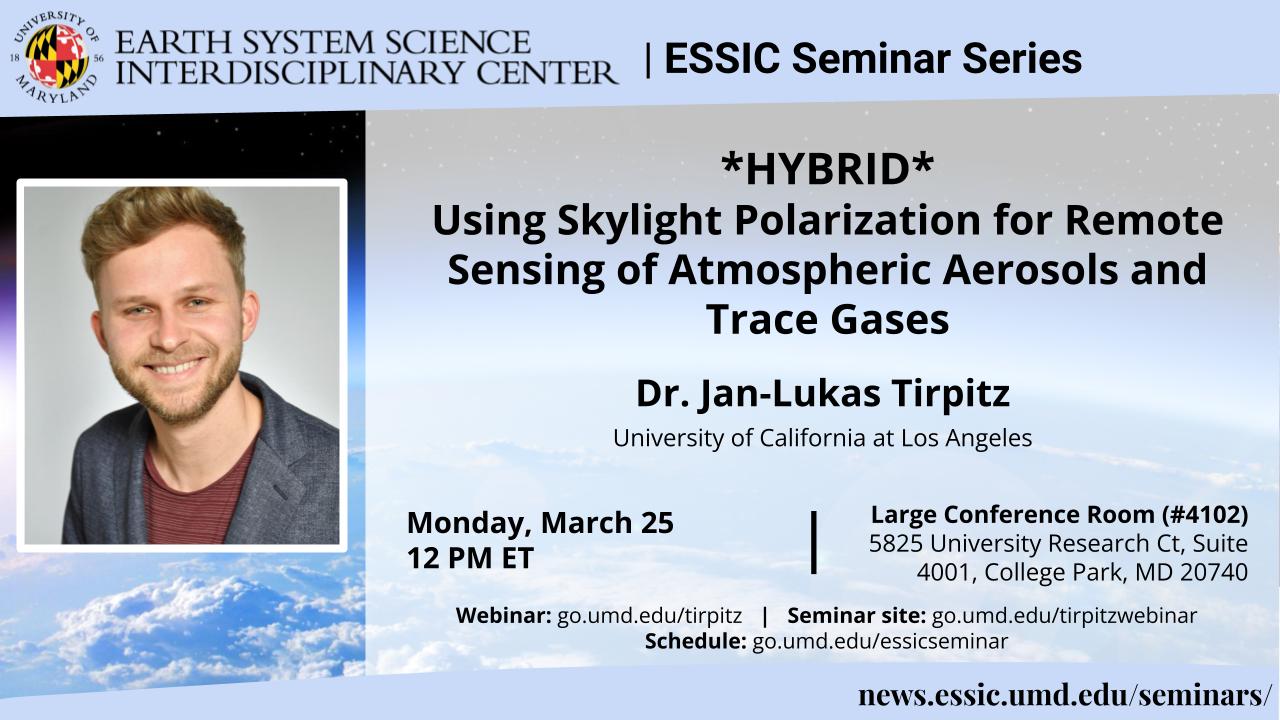
Using Skylight Polarization for Remote Sensing of Atmospheric Aerosols and Trace Gases
Dr. Jan-Lukas Tirpitz
University of California at Los Angeles
Monday March 25, 2024, 12 PM ET
Hybrid (In-Person & Virtual):
This seminar will be held at noon at room 4102 of ESSIC, 5825 University Research Ct. College Park, MD 20740. In-person attendance is welcome with refreshment provided. Zoom is also provided for virtual participants.
Hosts: Xi Shao and Changyong Cao
Abstract:
Multi-Axis Differential Optical Absorption Spectroscopy (MAX-DOAS) is a well-established remote sensing technique to infer information on atmospheric trace gases and aerosols. The method finds application in studies on atmospheric chemistry, pollution monitoring, and the validation of satellite observations. Conceptually, MAX-DOAS performs a form of tomography on the sky: ultraviolet and visible radiation spectra of skylight are recorded in multiple viewing directions (“Multi-Axis”), each evoking a different light path through the atmosphere. Analysis of the spectra for specific features and inverse modeling of the radiative transfer allows for the retrieval of aerosol and trace gas vertical distributions as well as aerosol properties. It is generally known that, besides the spectrum, also the polarization state of skylight contains valuable information: the degree of polarization strongly depends on aerosol abundance and properties, and – since the radiative transfer differs for light of different polarization – polarimetry allows to access additional light paths. We present results based on measurements from a novel polarization-sensitive MAX-DOAS instrument and a corresponding inversion algorithm, demonstrating the potential of polarimetry for ground-based aerosol and trace gas remote sensing.
Biosketch:
Jan-Lukas Tirpitz is an atmospheric physicist and postdoctoral researcher at the University of California Los Angeles (UCLA). His research focuses on atmospheric radiative transfer and the development of spectroscopic measurement techniques for aerosols and trace gases. During his graduate studies at the Institute for Environmental Physics at the University in Heidelberg, Germany, he developed in situ instrumentation for ground-based and airborne measurements of volcanic emissions. During his PhD, he worked on remote sensing methods, including the topic presented in the seminar. After defending his PhD thesis in 2021, he worked as a research scientist at Airyx GmbH in Eppelheim, developing commercial spectroscopic instrumentation. Since 2023, he has been affiliated with the Department of Atmospheric and Oceanic Sciences at UCLA, where he investigates radiative transport in wildfire plumes to study their photochemical processing and improve plume composition retrievals for environmental satellites.
Webinar:
Event site: https://go.umd.edu/tirpitz
Zoom Webinar: https://go.umd.edu/tirpitzwebinar
Zoom Meeting ID: 949 2295 6234
Zoom password: essic
US Toll: +13017158592
Global call-in numbers: https://umd.zoom.us/u/aMElEpvNu
For IT assistance:
Cazzy Medley: cazzy@umd.edu
Resources:
Seminar schedule & archive: https://go.umd.edu/essicseminar
Seminar Google calendar: https://go.umd.edu/essicseminarcalendar
Seminar recordings on Youtube: https://www.youtube.com/user/ESSICUMD

